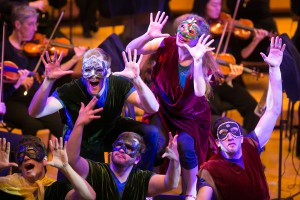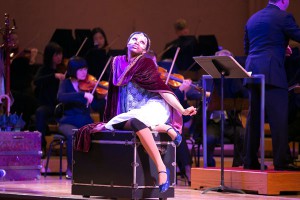By Frances Van de Vel
The older a joke gets, the more it loses its power and capacity to make people laugh. On Feb. 13, however, the Chicago Symphony Orchestra and guest artists from Chicago Shakespeare Theater proved the opposite with a playful performance of Felix Mendelssohn’s incidental music to Shakespeare’s “A Midsummer Night’s Dream.” Combining the stunning score, composed in the 19th century, with salient scenes from the play, written more than two centuries before, both ensembles brushed off the dust of ages to reveal fresh comedy material that elicited laughter from kids and adults alike.
Before the 11 a.m. performance, children were able to explore pre-concert activities in the rotunda of Symphony Center, the CSO’s home, to their heart’s content. Some wielded the baton in the Mini Maestros program, while those who preferred a place inside the orchestra lightly strummed a violin in the Instrument Petting Zoo.
Yet the CSO and their actor colleagues mainly aimed to spark musical imaginations through the fairy-tale comedy itself.
Edwin Outwater not only conducted the orchestra but was a performer in his own right. Acting as a narrator, he explained some scenes, promising a show about a “funny dream,” filled with a “hilarious accident and odd characters.” He said he would expose the audience to some magical music along with the Bard’s words, and that was exactly what he did. Outwater provided the connection between actors and musicians, all of whom brought top-level performances to the stage.
The Chicago Symphony Orchestra played four pieces of Mendelssohn’s incidental music: the Overture, the Scherzo, the Nocturne, and the “Wedding March.” The musical themes and emotions blossomed and grew into harmonies that revealed each instrumental section’s virtuosity without losing the delicate balance of their voices. The brass section lent jubilant grandeur to the “Wedding March,” arguably Mendelssohn’s best-known music. They glittered above lightly plucked strings that darted through the fairies’ theme and the soothing undercurrent of clarinet and bassoon. In the Nocturne, the horns spun a sweet soundscape with smooth, flowing phrases that suggested the “dark, calm, beautiful night” Outwater had asked them for.
The actors were equally alluring. Their scenes especially extracted both giggles and rapt attention from the children.
The theater rang with kids’ laughter at several key moments in Shakespeare’s venerable script, as the lovers dramatically professed their affection through extravagantly blown kisses, as thespian Bottom transformed into a donkey, and as fairy queen Titania fell hopelessly and comically in love with him. Although those scenes were penned more than 400 years ago, they delighted Symphony Center’s 21st-century children and their parents.
The actors’ costumes, which changed as they switched characters, added their own dramatic color. The young lovers played out their complicated romantic involvements in youthful blouses, dresses and jackets, while the fairies stole the spotlight with elaborate masks and robes of red, blue and green velvet. The fairy king’s servant Puck, merrily wreaking havoc among the lovers, looked especially fetching in a royal blue tunic with golden swirls and a laurel wreath circling his head.
The staging seemed sparse at first, the stage’s wooden flooring dotted only by five coat racks hung with the actors’ costumes. But the cast surprised with some ingenious props. By means of green umbrellas, torn and filled with glaring holes, they successfully evoked the sunlight falling though the forest canopy, light that danced on their faces in a whirl of golden specks.
So when Puck delivered the play’s last words, urging the audience to remember the events as nothing more than a dream, children and adults alike replied with a warm and genuine applause. It was a glowing answer to a blazing performance.
The Chicago Shakespeare Theater cast surprised with some ingenious props: torn umbrellas that made the stage light dance on their faces like sunshine. (Todd Rosenberg/CHICAGO SYMPHONY ORCHESTRA)






